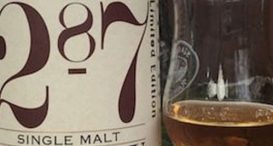The GreatDrams Guide to Building a Whisky Collection
One of the best things about being a collector is the fact that you can continually add to your collection. Whether it’s stamps, trainers, antiques, bottles, trading cards, coins, or anything else, building a collection is as enjoyable as it is satisfying.
It turns out that another thing people collect, that we here at GreatDrams find particularly interesting, is whisky. As you probably know, I’m partial to a dram or two now and then and I’m fortunate enough to have a decent collection of whisky myself. My humble collection, however, is nowhere near as impressive as some collectors’ out there.
When people think of whisky collections, they tend to envision ridiculously expensive and rare whisky, when in truth, you can collect whichever drams you like. You could opt for a smooth and fruity Speyside, a peated Islay, a Kentucky bourbon, a mellow and creamy Lowlands, or even a bottle from your local supermarket’s value range if you really wanted (though we wouldn’t recommend that).
If you’ve always dreamed of having your very own whisky collection, what are you waiting for? You can start building it right now, and we’ve several tips to help you do exactly that.
Understand the Different Types of Whisky
To begin with, if you’re really serious about building a whisky/whiskey collection, you’re going to have to understand the different types of whisky out there.
We here at GreatDrams tend to focus on Scotch, though we do also have other drams now and again. If you want to start building your whisky collection, it’s important to understand the different types of whisky that are out there.
While whisky/whiskey is produced all over the world, most would agree that the four most prominent types of whisky/whiskey are:
Scotch Whisky
Scotch is our whisky of choice here at GreatDrams, and it is one of the most complex and most popular drinks on the planet.
Made exclusively in Scotland, under stringent regulations, one of the best things about Scotch is the fact that the different regions it is produced in can yield very different results.
Islay whisky for example, is typically heavily peated and has smoky, earthy notes. Speyside whisky is usually peat-free and smooth and fruity. There’s also whisky produced in Campbeltown, which offers subtle peat and smoky notes, along with floral tones and maritime influences. If you’re looking for a whisky that covers all bases, Highland whisky is ideal, or for a milder, smoother, fruitier and creamier whisky, Lowlands whisky serves as the perfect introduction to the wonderful world of Scotch.
What I love about Scotch, is that it has such a diverse array of flavours. A dram from one distillery in the Highlands can taste completely different to one produced several miles away on the island of Islay.
Many whisky aficionados tend to base their collections solely on Scotch, and I can see exactly why that is.
Irish Whiskey
Travelling west, we have Irish whiskey.
Irish whiskey is typically milder than Scotch, and is renowned for its smoothness, not to mention the triple distillation process. It is also often blended.
Irish whiskey tends to offer a light sweetness, with notes of vanilla and caramel often present. There’s also often floral notes, fruity undertones, and maybe even a hint of spice. For those who like their whiskey smoother than Roger Moore as James Bond, this is a wonderful dram.
If you do decide to begin an Irish whiskey collection, there are plenty of brands out there to choose from, including Redbreast, Powers, and Bushmills, to name but a few.
American Whiskey
American whiskey is growing in popularity here in the UK, with rye in particular, finding its way into more and more bars and whiskey collections up and down the country.
American whiskey encompasses a wide range of different flavour profiles and styles, with rye whiskey, Tennessee whiskey, and bourbon whiskey in particular, being the most popular.
Rye whiskey for example, is typically spicier than bourbon and is almost similar to Scotch. Bourbon, which is made with a mash bill consisting of at least 51% corn, tends to be sweeter and offers notes of caramel, maple, vanilla, oak, and often oak smoke.
Japanese Whisky
Japanese whisky has been quietly growing in popularity over the last decade or so, and there is now an enormous market for this style of whisky.
Japanese whisky is very similar to Scotch and is meticulously made in a very similar way. It is renowned for its attention to detail, and smooth, floral, slightly fruity, slightly spicy character, usually with a touch of smoke to tie everything together.
Do Your Research
Once you’ve decided on which particular type of whisky you’d like to base your collection around, the next thing to do is to begin researching.
Of course, as it’s your collection you can collect whichever whiskies you like. My recommendation, however, is to opt for limited edition whiskies, rare whiskies, and award-winning whisky. This is due to the fact that they’re likely to be more valuable and will either hold their value or increase in value as time goes by.
If you’re collecting purely for taste however, these whiskies are likely to taste amazing as well!
On top of the whisky itself, do some research into the distillery. Does the whisky come from a reputable distillery well known for crafting fabulous drams, or are they relatively new and perhaps just getting started?
Put simply, the more you know about the whisky and where it’s made, the easier it will be to build your collection.
Visit Distilleries and Retailers
Here at GreatDrams, we’re lucky enough to have established a number of strong working relationships with distilleries up and down the nation. For me, that’s very important.
Rather than simply scrolling the web and ordering online, try to visit a few distilleries and whisky retailers so you can learn more about the spirit. You could opt for a guided tour, or maybe a tasting session. This can be useful because you can ask questions and learn more about whisky from experts who have dedicated much of their lives to this amazing spirit.
We have great relationships with many of our customers and we’re more than happy to answer any questions they may have. Not only do we try to put out as much informative whisky content as possible, but we’re also happy to speak to our customers and answer any questions about whisky that they may have.
By visiting distilleries and speaking to retailers, you can not only learn more about whisky, but you can find out about special offers, limited-editions, upcoming awards events, flavour profiles, and so much more.
Don’t Overlook Younger Whiskies
One of the most common misconceptions in the wonderful world of whisky, is that younger whiskies are always inferior to older whiskies. This is not the case at all.
Don’t get us wrong, aged whisky can taste unreal, but so too can younger whisky. A 4 year old single malt for example, could very well taste much better, and have a much better profile than a 15 year old. Some whisky gets worse as it ages, whereas other whiskies get better.
If you want to build a whisky collection, however, don’t just assume that younger whiskies aren’t going to be any good. I’ve tried whiskies aged for 4 years that have tasted phenomenally better than some whiskies aged for 15. In whisky, age isn’t everything.
Basically, what I’m trying to say here is that you shouldn’t be afraid to add younger malts to your collection, especially if you enjoy them.
Give Yourself a Budget
Building a whisky collection is a great pastime. It’s also one that could potentially get very expensive.
With seemingly everything increasing in price at the moment (as I write this, I’m looking at a letter from our broadband provider informing us that the price of our current package is increasing once again) it’s important to manage our money and budget whenever possible.
Whisky can vary hugely in price, so to ensure you don’t wind up in financial difficulty, make sure you set a budget, and stick to it. How much is entirely down to you, but please don’t think you need to spend a fortune to build a whisky collection, because you don’t. We have whisky starting at just £45, and if we do say so ourselves, it’s every bit as special as some of the more expensive offerings we’ve seen out there.
To make things more manageable, you could maybe limit your buying to one bottle each month, or a set amount per month, purely for whisky.
Buy a Ready-Made Collection
Rather than building a whisky collection yourself, how about purchasing a collection instead?
Here at GreatDrams, to help make your whisky collection journey that little bit easier, we’ve put together this collection of four limited edition whisky bottles to help get you started.
This collection provides a wide array of different whiskies of different ages, with different flavour profiles and characteristics. Each one is completely unique to the last, yet equally as delicious.
For those just looking to start building a whisky collection, a ready made collection just like the one we offer is a fantastic place to begin with.
Enjoy It
Finally, the last tip we have for you today is arguably the most important, and that is to enjoy it.
For me personally, if I own a whisky, I want to enjoy it and savour every last drop. I don’t just want to leave it in a cupboard gathering dust. I want to showcase it proudly and when the time’s right, I want to pour myself a glass or two, and enjoy it.
Whether you plan on saving it for a special occasion, breaking a bottle out over Christmas, or simply pouring yourself a wee dram from your collection after a long week at work, make sure you enjoy each and every single whisky you have in your collection.














